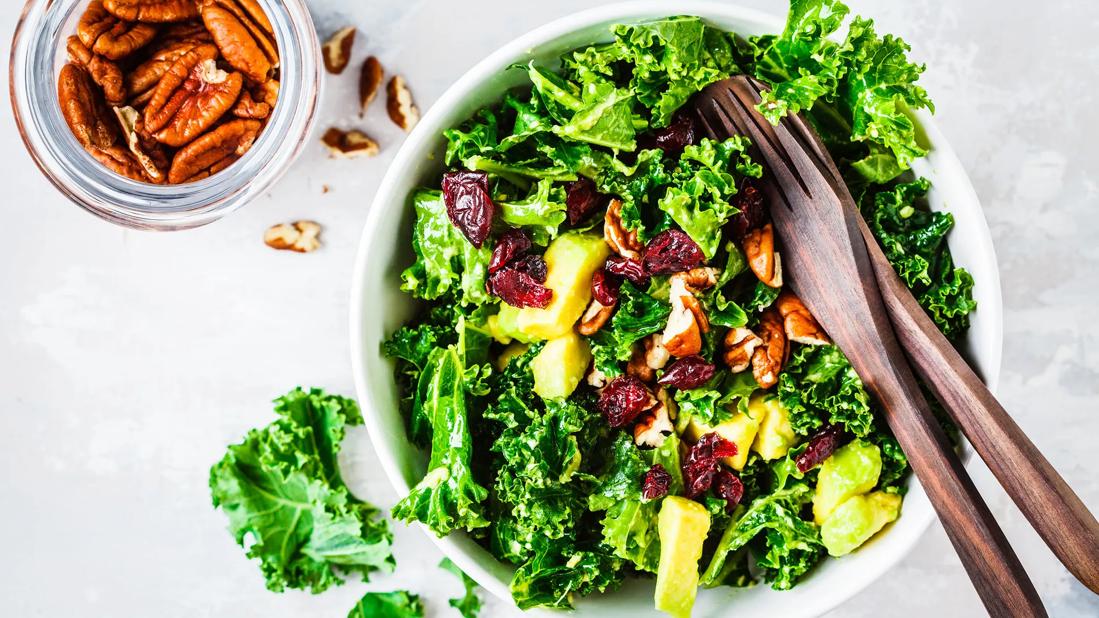This leafy green can boost digestion and eye health, remove toxins and fight cancer and inflammation

Kale may not be everyone’s first choice at the dinner table, but don’t underestimate this veggie. Packed with disease-fighting nutrients, kale deserves a starring role on your plate.
Advertisement
Cleveland Clinic is a non-profit academic medical center. Advertising on our site helps support our mission. We do not endorse non-Cleveland Clinic products or services. Policy
“Kale is more than just a healthy leafy green,” says registered dietitian Michela Palma, RD, LD. “It has an impressive list of nutrients that provide many disease-fighting benefits. And it’s easier to incorporate into your diet than you may think.”
There are lots of ways to prepare and eat this nutrient-packed vegetable — you can probably find one that suits your taste buds.
Kale is a fibrous, leafy green cruciferous vegetable. It’s part of the Brassicaceae family, along with other greens like collards, broccoli, Brussels sprouts, cabbage and cauliflower.
Nutrients in kale may benefit your health in several ways. They can help fight cancer, inflammation, boost eye health, remove toxins and enhance digestion.
“There are many varieties of kale,” adds Palma. Different types of kale offer varying textures and slight differences in flavor. Types of kale you’re likely to find include:
Kale is low in calories, high in fiber and full of beneficial nutrients. One cup of raw kale provides:
Advertisement
One cup of kale also contains:
Is kale a superfood? “Yes, we consider dark, leafy greens like kale to be superfoods due to their high antioxidant, fiber, mineral and vitamin content,” confirms Palma. “Superfoods are exceptionally dense in health-promoting nutrients.”
Palma shares some of the top health benefits of kale.
“Research suggests that phytonutrients found in kale and other Brassicas may absorb and help eliminate toxins in the digestive tract,” says Palma. In the study, molecules in kale absorbed several different mycotoxins — harmful waste produced by fungi that often contaminate foods.
Mycotoxins can cause liver damage and other health issues. The research results are promising, but researchers need to do more studies to fully understand kale’s detox power.
Kale contains potent antioxidants that are especially good for your eyes and vision:
No single food can prevent cancer. But a diet high in cruciferous veggies like kale may help lower your risk of:
According to the National Cancer Institute, unique molecules in kale (including glucosinolates, indoles and sulforaphane) may:
Palma notes that many of these studies were performed on cells or models. “We need human studies to confirm that kale and other cruciferous vegetables have these anticancer effects in people,” she says.
Your gut microbiome is made up of the beneficial bacteria and microbes that help you digest food. A healthy microbiome also benefits your immune system, fights inflammation and boosts mental health.
“Kale provides prebiotics — food for the beneficial bacteria in your digestive system,” shares Palma. According to research, eating kale can also help relieve constipation.
Inflammation is a natural response to illnesses and injuries. But long-term inflammation contributes to many chronic diseases and cancers. “Kale provides a unique mix of several antioxidants and other nutrients that work to stop inflammation,” says Palma.
Advertisement
Kale contains:
For most people, kale is safe to eat. But Palma notes a few precautions to take:
You can eat kale raw, wilted or sautéed. Try adding it to any salad or savory dish that contains other vegetables. Here are some recipe ideas to help get you started:
Advertisement
Advertisement
Learn more about our editorial process.
Advertisement

Eating too much salt can put extra pressure on your blood vessels and heart

High in antioxidants and vitamin C, kohlrabi lowers disease risk, protects your heart and aids digestion

The gluten-free, fiber-rich superfood supports gut and heart health and can help with diabetes management

Wasabi root may protect against cancer, food poisoning and memory loss

Limes and lime juice are rich in vitamins, minerals, antioxidants and other nutrients

This herbal drink may ease allergies and boost prostate health

The common flavor enhancer has had a bad reputation — but here’s what the research shows

This ancient grain, packed with protein and fiber, can help with weight loss and heart health

Leg-related symptoms indicate DVT, while chest symptoms point to a pulmonary embolism

There are many different ways to love someone and yourself

Looking down at your smartphone or computer screen can stress muscles in your neck, shoulders and back